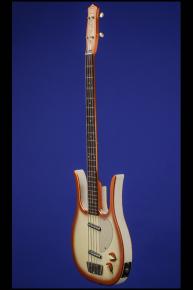1962 Danelectro Long Horn Bass
One of the Most Distinctive Instrument Designs of its Era
1962 Danelectro Longhorn Bass
This 13 1/8 inch-wide, 1 5/8 inch deep, double-cutaway (long-horn) hollow-body bass guitar weighs just 6.30 lbs. Masonite top and back back over a pine frame with white vinyl edging. Two metal strap buttons. One-piece poplar neck with a nut width of just under 1 11/16 inches, a scale length of 30.00 inches and a medium-to-thio profile. Three screw neck-to-body attachment with dual steel non-adjustable "Never Warp" truss rod system. Brazilian 'Slab' rosewood fretboard with aluminium nut with 24 original medium frets, white plastic position dot markers and silver side dot markers. 'Coke-Bottle' shaped headstock with "Danelectro" vertically silk-screened in brown. Open-back Kluson Deluxe two-a-side strip tuners with oval white plastic buttons. Two "Lipstick-Tube / Split-Shell" pickups with alnico bar magnets and outputs of 11.65k and 11.30k. The height of each pickup can be adjusted via two screws on the back of the body. Two volume controls with concentric on/off switches. Coppermist plastic concentric control knobs with white wooden pointers on/off switches. Combination Brazilian rosewood bar bridge, aluminium 'trapeze' tailpiece secured to top by three screws. Polished stainless-steel control cavity cover on back secured by two screws. The serial number "1122" (11th week of 1962) is stamped in the neck pocket. This super-light Longhorn Bass guitar is in near mint (9.25) condition with just a few tiny surface marks on the top edge. Housed in a later three-latch, rectangular black hardshell case with blue plush lining (9.25).
"Danelectro went on to add a very distinctive bass to their catalog around 1958, the twenty-four fret Long Horn model available in four-and six-string versions, followed by a more conservative Short Horn bass with just fifteen frets in 1959. Nathan Daniel explains the outrageous look of the Long Horn bass as purely practical: "The idea was simply to give the player as much access as possible, which meant instead of a single cutaway, we had a deep cutaway on both sides. It did make an unusual look, sure, but it was an unusual name too: a couple of long horns," he laughs." (Tony Bacon. The Bass Book. p. 21)
"Sometimes cheaper is better - or at least more fun. As if to prove that very point, Nathan Daniel began to build basses and guitars in the mid 1950s that were inexpensive yet still credible as musical instruments. The bodies were made of Masonite, mounted on poplar frames that were stapled together, with decorative strips of pebbled vinyl glued around the edges. The necks have no trussrods, just square aluminium tubes down the middle. The single-saddle bridges couldn't be adjusted. The pickups were mounted in surplus lipstick tubes…
Danelectro's true electric bass guitars (30" scale length) came in Long Horn and Short Horn models, the names being accurate descriptions of the body shapes. The Long Horn was one of the most distinctive instrument designs of its era and remains a favorite of collectors. Both body styles came in standard 4 - and 6-string (EADGBE) models. The standard finishes included a striking "bronze burst" effect. (Jim Roberts. American Basses. p.44-45).












